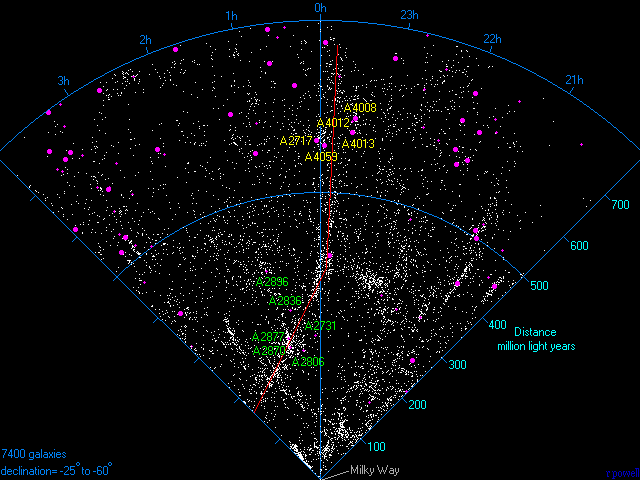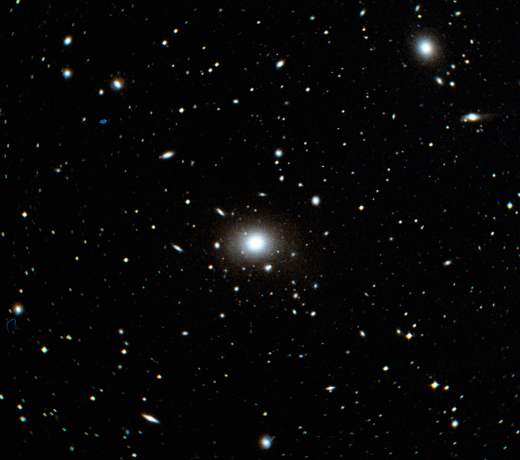
The superclusters in the Sculptor region of the sky are not obvious structures. This map is a plot of the brightest galaxies (from the Principal Galaxies Catalogue) in this region of the sky and although the locations of the main clusters are marked, the superclusters are hard to see. The Sculptor superclusters are important however because they are contained within a major wall of galaxies which sweeps through this region of the sky across nearly a billion light years of space.

Below is a list of the clusters in the two Sculptor superclusters. The nearest of the two superclusters is mainly within the constellation of Phoenix and so is perhaps best called the Phoenix supercluster. Note that the six clusters in this Phoenix supercluster are all of richness class zero. This means that none of them are impressive clusters. The second supercluster (which is mainly in Sculptor) does contain richer clusters but they are also much further away and harder to see.
1 2 3 4 5 6 7
Abell Equatorial Redshift Distance Rich Notes
Number Coordinates z Mly
RA Dec
A2731 00 10.2 -56 59 .0300 415 0
A2806 00 40.2 -56 10 .0265 365 0
A2836 00 53.7 -47 37 .0288 395 0
A2870 01 07.7 -46 55 .0225 310 0
A2877 01 09.8 -45 54 .0235 325 0
A2896 01 18.3 -37 06 .0306 420 0
A2717 00 03.3 -35 57 .0478 650 1
A4008 23 30.3 -39 19 .0537 730 1
A4012 23 31.8 -33 49 .0498 680 0
A4013 23 31.9 -35 16 .0488 665 1
A4059 23 56.7 -34 40 .0463 630 1
|
Column 1: The name/number of the cluster.
Column 2: The Right Ascension for epoch 2000.
Column 3: The Declination for epoch 2000.
Column 4: The redshift of the cluster.
Column 5: The distance in millions of light years assuming H=70km/s/Mpc.
Column 6: The 'richness' class of the cluster.
Column 7: Additional names and notes.
References:
Abell G, Corwin H, Olowin R, (1989), A catalogue of Rich Clusters of Galaxies,
Astrophys J Supp, 70, 1.
Struble M, Rood H, (1999), A compilation of redshifts and velocity dispersions for
ACO clusters, Astrophys J, 125, 35.
The map below is a slice of the universe which shows the Sculptor Wall. This map is a plot of 7400 bright galaxies (from the HyperLeda database) in the vicinity of the Sculptor Wall. Our galaxy is at the bottom and the top of the map is 800 million light years away. The red line shows the Sculptor Wall which is sometimes called the Southern Wall. The wall is faint beyond 500 million light years because the data is incomplete beyond that distance. Notice that the nearest part of the wall (the Phoenix supercluster) lies next to a large rectangular void. This is called the Sculptor Void, and it is one of the largest voids in the nearby universe.

The Sculptor wall was brought to the attention of astronomers by A Maurellis, A Fairall, D Matravers and G Ellis in 1990. They published a paper announcing their discovery of a major wall of galaxies lying between voids. The paper contains a map of the wall which only shows the nearest of the two superclusters.
Later, in 1994, da Costa, Geller, Pellegrini, Latham, Fairall, Marzke, Willmer, Huchra, Calderon, Ramella and Kurtz combined the surveys for the Coma and Sculptor superclusters in another paper. They published a map, which looks out into the universe in two directions and it shows the Coma wall at the top and the Sculptor wall at the bottom.
Below is a picture of the A2877 cluster, it is probably the most impressive of the clusters in these two superclusters because it is dominated by the giant elliptical galaxy IC 1633. This galaxy has a diameter greater than 270 000 light years and it rivals the two huge galaxies in the Coma cluster in terms of size and luminosity.
